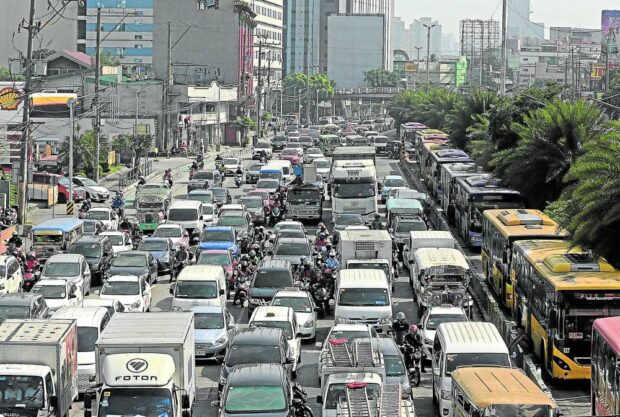
Heavy traffic is seen along EDSA in Pasay City. INQUIRER FILE PHOTO / RICHARD A. REYES
The Metropolitan Manila Development Authority (MMDA) on Friday said the authorities have already implemented necessary traffic management interventions as it sought to clarify a 2023 study stating that Metro Manila has the worst traffic among 387 metro areas in the world.
In a press conference, MMDA Acting Chair Romando Artes said that the agency will reach out to those behind the 2023 TomTom Traffic Index to ask them of the methodologies used in the study. TomTom is a Netherlands-based multinational developer and creator of location technology and consumer electronics.
“We want to know the methodology employed. If there is an actual count and when did they conduct the study,” Artes said.
He cited as an example Quezon Avenue, which according to the study was the busiest street in Metro Manila last year.
“Per our data, it is still Edsa as Metro Manila’s busiest road based on our regularly conducted actual count. With this alone, we can see that there is a difference between our data and TomTom’s,” he said. “Quezon Avenue is only the third busiest road per our data.”
READ: Metro Manila motorists spent nearly ‘5 days’ stuck in traffic in 2023
Department of Transportation (DOTr) Secretary Jaime Bautista, reacting to TomTom’s listing, said the government already has ongoing road transport infrastructure projects “directed at improving commuter experience while addressing worsening traffic in highly urbanized areas.”
“The top ranking of Metro Manila in the world traffic poses a challenge not just for DOTr but other agencies as well to be creative at finding lasting solutions to metro traffic. We will fast-track road projects while collaborating with appropriate agencies with the help of the private sector,” Bautista said in a statement.
Metro Manila topped the 2023 TomTom Traffic Index, which listed 387 metropolitan areas. The index said driving for 10 kilometers in the metropolis takes an average of 25 minutes and 30 seconds.
Following Metro Manila are Lima, Peru; Bengaluru, India; Sapporo, Japan; Bogota, Colombia; Taichung, Taiwan; Mumbai, India, Kaoshiung, Taiwan; Pune, India; and Nagoya, Japan.
In a separate statement, Artes acknowledged that traffic congestion in the metropolis is a decades-old problem and attributed it to various factors, such as: vehicle volume, lane blockages, diggings and road repairs, ongoing construction of government flagship infrastructure projects, road configuration and conditions, and suspension of the No Contact Apprehension Policy.